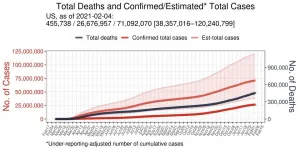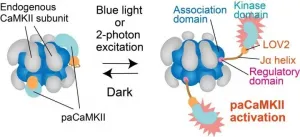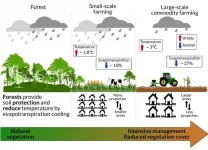(Press-News.org) DALLAS - Feb. 8, 2021 - World health experts have long suspected that the incidence of COVID-19 has been higher than reported. Now, a machine-learning algorithm developed at UT Southwestern estimates that the number of COVID-19 cases in the U.S. since the pandemic began is nearly three times that of confirmed cases.
The algorithm, described in a study published today in PLOS ONE, provides daily updated estimates of total infections to date as well as how many people are currently infected across the U.S. and in 50 countries hardest hit by the pandemic.
As of Feb. 4, according to the model's calculations, more than 71 million people in the U.S. - 21.5 percent of Americans - had contracted COVID-19. That compares with the substantially smaller 26.7 million publicly reported number of confirmed cases, says Jungsik Noh, Ph.D., a UT Southwestern assistant professor in the Lyda Hill Department of Bioinformatics and first author of the study.
Of those 71 million Americans estimated to have had COVID-19, 7 million (2.1 percent of the U.S. population) had current infections and were potentially contagious on Feb. 4, according to the algorithm.
Noh's written study is based on calculations completed in September. At that time, it reports, the number of actual cumulative cases in 25 of the 50 hardest-hit countries was five to 20 times greater than the confirmed case numbers then suggested.
Looking at the current information available on the online algorithm, the estimates are now closer to the reported numbers - but still much higher. On Feb. 4, Brazil had more than 36 million cumulative cases as estimated by the algorithm, almost four times more than the 9.4 million confirmed cases reported. France had 14 million versus the 3.2 million reported. And the United Kingdom had almost 25 million instead of about 4 million - more than six times as many. Mexico, an outlier, had nearly 15 times its reported number of cases - 27.6 million rather than 1.9 million confirmed cases.
"The estimates of actual infections reveal for the first time the true severity of COVID-19 across the U.S. and in countries worldwide," says Noh.
The algorithm uses the number of reported deaths - thought to be more accurate and complete than the number of lab-confirmed cases - as the basis for its calculations. It then assumes an infection fatality rate of 0.66 percent, based on an earlier study of the pandemic in China, and considers other factors such as the average number of days from the onset of symptoms to death or recovery. It also compares its estimate with the number of confirmed cases to calculate a ratio of confirmed-to-estimated infections.
Much is still uncertain about COVID-19 - particularly the death rate - and the estimates are therefore rough, Noh says. But he believes the model's estimates are more accurate and leave out fewer cases than the confirmed ones currently used as guidance for public health policies. Having a more comprehensive estimate about the prevalence of the disease is important, Noh adds.
"These are critical statistics about the severity of COVID-19 in each region. Knowing the true severity in different regions will help us effectively fight against the virus spreading," he explains. "The currently infected population is the cause of future infections and deaths. Its actual size in a region is a crucial variable required when determining the severity of COVID-19 and building strategies against regional outbreaks."
In the U.S., infection rates vary widely by state. California has had almost 7 million infections since the pandemic's start compared with New York's 5.7 million, according to the algorithm's projections for Feb. 4. Also, the model estimated California had 1.3 million active cases on that date, affecting 3.4 percent of the state's population.
Other model estimates for Feb. 4: In Pennsylvania, 11.2 percent of the population had current infections - the highest rate of any state, compared with a low of 0.15 percent of those living in Minnesota; in New York, an early hot spot, 528,000 people had active infections, or about 2.7 percent of its population. Meanwhile, in Texas, 2.3 percent had current infections.
Noh says he developed the algorithm last summer while trying to decide whether to send his sixth-grade daughter back to school in person. There was nowhere to find the data he needed to gauge the safety of doing so, he says.
Once he built the machine algorithm, he discovered the area where he lived had about a 1 percent current infection rate. So his daughter went to school.
Noh checked his findings by comparing his results with existing prevalence rates found in several studies that used blood tests to check for antibodies to the SARS-CoV-2 virus, which causes COVID-19. For most of the areas tested, his algorithm's estimates of infections closely corresponded to the percentage of people who had tested positive for the antibodies, according to the PLOS ONE study.
The online model uses COVID-19 death data from Johns Hopkins University and The COVID Tracking Project, a volunteer organization founded to help track COVID-19, to run its daily updates. However, the estimates published in the PLOS ONE study date from Sept. 3. At that time, about 10 percent of the U.S. population had been infected with COVID-19, based on Noh's algorithm.
INFORMATION:
Gaudenz Danuser, Ph.D., chair of the Lyda Hill Department of Bioinformatics and professor of cell biology, was senior author of the study. He also holds the Patrick E. Haggerty Distinguished Chair in Basic Biomedical Science.
Funding came from Lyda Hill Philanthropies.
As teens' use of social media has grown over the past decade, so too has the suicide rate among younger people, with suicide now being the second leading cause of death among those ages 10 to 34. Many have suggested that social media is driving the increased suicide risk, but because social media is still relatively new, it's been difficult to determine its long-term effects on mental health.
In the longest study to date on social media use and suicidality, BYU research recently published in the Journal of Youth and Adolescence now offers some answers.
Through ...
One of the dozens of unusual symptoms that have emerged in COVID-19 patients is a condition that's informally called "COVID brain" or "brain fog." It's characterized by confusion, headaches, and loss of short-term memory. In severe cases, it can lead to psychosis and even seizures. It usually emerges weeks after someone first becomes sick with COVID-19.
In the February 8, 2021, issue of the journal Cancer Cell, a multidisciplinary team from Memorial Sloan Kettering reports an underlying cause of COVID brain: the presence of inflammatory molecules in the liquid surrounding the brain and spinal cord (called the cerebrospinal fluid). The findings suggest that anti-inflammatory drugs, such as steroids, may ...
Exposure to sexual assault in the U.S. military doubled the odds that a service member would leave the military within 28 months, and sexual harassment was associated with roughly 8% of all military separations during this same time period, according to a new report from the RAND Corporation.
Specifically, the report estimates that sexual assaults were associated with 2,000 more separations than would normally be expected, and another 8,000 separations were associated with sexual harassment.
"Sexual assault and sexual harassment are associated with a wide range of harms to individual service members, but this study highlights another negative impact of these crimes - higher rates of attrition and associated harms to force readiness." said Andrew ...
The world is changing rapidly and in order to serve the human population dealing with those changes, American universities need to change, too. In fact, their role is to model the resiliency that all institutions need to embrace, according to Arizona State University President Michael M. Crow.
While many leading universities are poised to advance society and help respond to the challenges of disruptive change through their traditional role in education and discovery, many face a number of barriers that make them less prepared to respond to the rapidly changing conditions and the demands they create.
What is emerging is a new type of university, one that steps beyond the American research university model and ...
Not all friendships are created equal. Some friends get along; others struggle to avoid conflict. Conventional wisdom holds that the tenor of a friendship with someone who is nice differs from that with someone who is mean, such that the former discourages negative interactions whereas the latter aggravates them. Although it is logical to assume that children who are mean have friendships characterized by growing strife and that children who are nice report little of the same, these assumptions have not yet been tested in the real-world friendships of children.
Researchers from Florida Atlantic University's Charles E. Schmidt College of Science are the first to conduct a longitudinal study to examine the extent to which being "nice" (prosocial behavior) and being "mean" (relationally aggressive ...
A new study from University of Alberta researchers has shown that traumatic or stressful events in childhood may lead to tiny changes in key brain structures that can now be identified decades later.
The study is the first to show that trauma or maltreatment during a child's early years--a well-known risk factor for developing mental health conditions such as major depressive disorder in adulthood--triggers changes in specific subregions of the amygdala and the hippocampus.
Once these changes occur, researchers believe the affected regions of the brain may not function as well, potentially increasing the risk of developing mental health disorders as adults during times of stress.
"Now ...
CORVALLIS, Ore. - Marching band members in leadership roles are more likely to feel discomfort in the neck and upper back than their less experienced bandmates, who in turn are more susceptible to left-hand pain and cognitive strain, a new study by Oregon State University suggests.
The findings also showed that gender had no bearing on how much discomfort a musician felt or the band member's perception of workload.
"The study really seems to indicate that a player's level of experience and role within the band are what drive how much discomfort they feel," said industrial ...
Neurons are the primary cells of the nervous system, and the signals that are transmitted between them are responsible for all our actions and our cognitive ability. In particular, learning and memory are believed to be associated with a process called "long-term potentiation," which is the strengthening of connections between specific neurons via continued signal transmission through "synapses" (small gaps between neurons). Long-term potentiation can change the connection between neurons via synapses--by changing their size and composition. Understanding ...
Researchers report that large-scale commercial farms on deforested land in the southern Amazon result in higher temperature increases and less rainfall than small-scale farms.
Deforestation has converted swaths of land in the southern Amazon region from rainforest to farmland. The uses of the deforested land are diverse, and activities can range from small-scale farming in rural settlements to large-scale commodity agriculture. Commercial farms in the Southern Amazon can reach hundreds of thousands of hectares in area, exporting millions of tons in grains and beef every year.
Eduardo Maeda from the University of Helsinki and colleagues used satellite data to compare areas dominated by different land uses and farm sizes to evaluate their impacts on ...
Li-ion batteries (LIBs) are widely used in various mobile electronics. Concerns of global warming and climate change have recently boosted the demand for LIBs in electric vehicles and solar photovoltaic output smoothing. Si has been studied as an active material with a high theoretical capacity of 3578 mAh/g, which is around ten times higher than that of graphite (372 mAh/g).
Now, a team of researchers at Osaka University has used flake-shaped Si nanopowder wrapped by ultrathin graphite sheets (GSs) to fabricate LIB electrodes with high areal capacity and current density.
Generally ...





